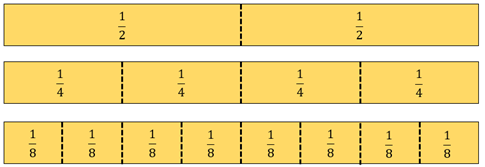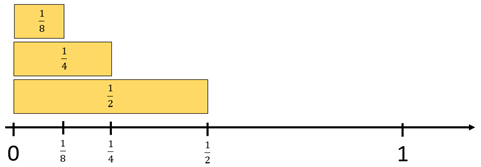Purpose
The purpose of this activity is to support students understanding that unit fractions are created through equal partitioning.
Achievement Objectives
NA3-1: Use a range of additive and simple multiplicative strategies with whole numbers, fractions, decimals, and percentages.
NA3-5: Know fractions and percentages in everyday use.
Required Resource Materials
- Strips of paper
Activity
- Challenge students to fold strips of paper of equal lengths into halves, quarters, and eighths. Using strips of equal lengths will allow you to build a number line with the pieces created.
- Label each piece with a fraction symbol and practice saying the words, “one half”, “one quarter”, and “one eighth.” Make connections between these terms and the symbols they are represented by. You might also make connections with relevant te reo Māori kupu, such as hautau (fraction).

- Discuss the meaning of numerator and denominator.
What does the 2 in the fraction, one half, mean? (One is divided into two equal parts)
What does the 4 in the fraction, one quarter, mean? (One is divided into four equal parts)
What does the 8 in the fraction, one eighth, mean? (One is divided into eight equal parts)
What does the 1 mean in one half, one quarter, and one eighth? (One of the parts is counted).
- Use the fraction pieces to make a number line with unit fractions. Note the length of the original strip gives the location of 1 as a distance from zero.

- Use a number line and fraction strips to draw students’ attention to the location of 1 and a range of unit fractions. Ensure the beginning of each fraction strip is aligned with zero. Support students to notice, and make connections between, the different endpoints of each fraction strip and the end of the unit of 1.

- Establish the idea that the more equal parts the one (whole) is divided into, the smaller the parts are.
What do you notice about the size of the fractions?
Why is one quarter less than one half?
Why is one eighth less than one quarter?
Next steps
- Increase the level of abstraction by progressing from physically locating and comparing fraction strips, to working with a drawn number line drawn and range of increasingly complex unit fraction pieces.
- Increase the complexity by supporting students to use halving, thirding, doubling, and iteration to locate a wider range of unit fractions, such as 1/3, 1/6, and 1/12, in relation to the given length of one.
- Encourage students to think about the fractions created if these actions are repeated. For example:
If we divide eighths in half, what fraction do we get? (sixteenths)
Add to plan
Level Three